
The George Washington Birthplace National Monument is a national monument in Westmoreland County, Virginia, at the confluence of Popes Creek and the Potomac River. It commemorates the birthplace location of George Washington, a Founding Father and the first President of the United States, who was born here on February 22, 1732. Washington lived at the residence until age three and later returned to live there as a teenager.

Parkland Memorial Hospital is a public hospital in Dallas, Texas, United States. It is the main hospital of the Parkland Health & Hospital System and serves as Dallas County's public hospital. It is located within the Southwestern Medical District. The hospital is staffed by the faculty, residents, and medical students of UT Southwestern Medical Center.
The campus of the University of California, Berkeley, and its surrounding community are home to a number of notable buildings by early 20th-century campus architect John Galen Howard, his peer Bernard Maybeck, and their colleague Julia Morgan. Subsequent tenures as supervising architect held by George W. Kelham and Arthur Brown, Jr. saw the addition of several buildings in neoclassical and other revival styles, while the building boom after World War II introduced modernist buildings by architects such as Vernon DeMars, Joseph Esherick, John Carl Warnecke, Gardner Dailey, Anshen & Allen, and Skidmore, Owings and Merrill. Recent decades have seen additions including the postmodernist Haas School of Business by Charles Willard Moore, Soda Hall by Edward Larrabee Barnes, and the East Asian Library by Tod Williams Billie Tsien Architects.

Heritage Hall is the oldest building on the campus of Valparaiso University in the U.S. state of Indiana. Built in 1875 by John Flint, it was used as a residence hall for men. In 1878, a fire destroyed the third floor. The building was later purchased by Richard Abraham Heritage, remodeled into a two-story school of music, and renamed Heritage Hall. At different times throughout its history, Heritage Hall underwent renovations. It was used as a dormitory, a barracks, a machinery classroom, and finally a library when Valparaiso University was bought by the Lutheran University Association in 1925. In 1959, the new Moellering Library had been completed and the building was converted to classrooms and offices. Heritage Hall was placed on the National Register of Historic Places in 1976.

University Hospital is located in Columbia, Missouri. It has the only Level I trauma center and helicopter service in Mid-Missouri, and the only burn intensive care unit in the region. It also has an accredited chest pain center cardiology program and a multidisciplinary digestive disease program. The hospital is affiliated with the University of Missouri and the University of Missouri School of Medicine.

Houston Hall is the student union of the University of Pennsylvania, in Philadelphia, Pennsylvania. Completed in 1896, it was the first student union built on an American college campus.
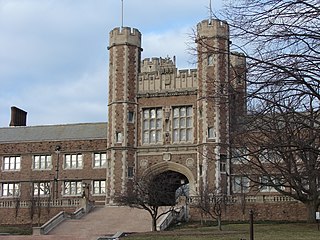
The Washington University Hilltop Campus Historic District was the site of the 1904 Louisiana Purchase Exposition and the 1904 Summer Olympics. Many of the exposition buildings were temporary in nature, but a number of permanent structures were built and are used by Washington University, which calls this area the Danforth Campus. The district includes more than fifty structures, of which twenty are in the Collegiate Gothic style.

The Loring Residence and Clinic was the first facility built to provide medical services to Valparaiso, Indiana. The residence has continued to provide for public service through its current use by the Valparaiso Woman's Club. Dr. Loring used his home as his medical office until his death in 1914. It was Loring's initial efforts that brought medical care to the county and provided for the first hospital. Although private, it became the county's first public hospital when Loring sold the building in 1906 to build his home and clinic.
The campus of the George Washington University (GW), originated on College Hill, a site bounded by 14th Street, Columbia Road, 15th Street and Florida Avenue, NW in the Columbia Heights neighborhood of Washington, D.C. After relocating to the downtown financial district in the 1880s and then to Foggy Bottom in 1912, GW now has three campuses. Foggy Bottom is the location of the university's main campus in Washington, D.C. Also in Washington's Foxhall neighborhood is the Mount Vernon Campus, formerly the Mount Vernon College for Women. Additionally, the George Washington University Virginia Campus is located in Ashburn, VA.

The University of Missouri is a public land-grant research university in Columbia, Missouri. It is Missouri's largest university and the flagship of the four-campus University of Missouri System. MU was founded in 1839 and was the first public university west of the Mississippi River. It has been a member of the Association of American Universities since 1908 and is classified among "R1: Doctoral Universities – Very high research activity".

The Samuel Hahnemann Monument, also known as Dr. Samuel Hahnemann, is a public artwork dedicated to Samuel Hahnemann, the founder of homeopathy. It is located on the east side of Scott Circle, a traffic circle in the northwest quadrant of Washington, D.C. The Classical Revival monument consists of an exedra designed by architect Julius Harder and a statue sculpted by Charles Henry Niehaus, whose works include the John Paul Jones Memorial in Washington, D.C., and several statues in the National Statuary Hall Collection. The monument is significant because Hahnemann is the first foreigner not associated with the American Revolution to be honored with a sculpture in Washington, D.C.
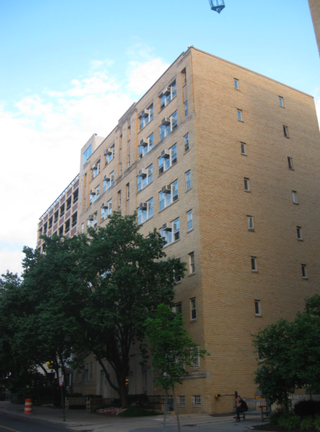
Munson Hall is a residence hall on the campus of George Washington University, located at 2212 Eye St., Northwest, Washington, D.C. in the Foggy Bottom neighborhood.

Corcoran Hall is an academic building on the campus of George Washington University in Washington, D.C. It was listed on the District of Columbia Inventory of Historic Sites in 1987 and the National Register of Historic Places in 1991.

Madison Hall, formerly known as the Flagler Apartments, is a residence hall on the campus of George Washington University (GW) in Washington, D.C. The building was designed by Stern and Tomlinson and was built in 1926. The building is representative of the apartment buildings that were built from the 1920s to the 1940s that have been acquired by the university and converted into dormitories. GW bought the building in 1957 and replaced its manually operated elevators during its renovations. The building was named for both James Madison and Dolley Madison. It was listed on the District of Columbia Inventory of Historic Sites and the National Register of Historic Places in 2010.
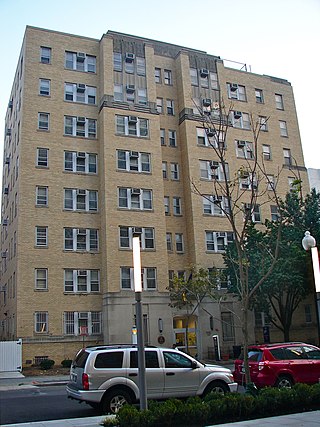
Jacqueline Bouvier Kennedy Onassis Hall is a residence hall on the campus of the George Washington University, in Washington, DC. It is named after GW alumna Jacqueline Bouvier Kennedy Onassis, former First Lady of the United States.
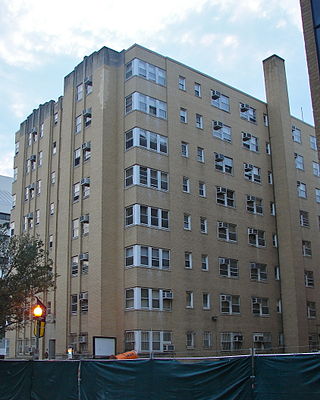
Fulbright Hall, formerly known as The Everglades, is an undergraduate residence hall on the Foggy Bottom campus of the George Washington University (GW), named after J. William Fulbright, located at 2223 H St., Northwest, Washington, D.C., in the Foggy Bottom neighborhood.

Stockton Hall is a building on the campus of George Washington University in Washington, D.C. It was listed on the District of Columbia Inventory of Historic Sites in 1987 and on the National Register of Historic Places in 1991.
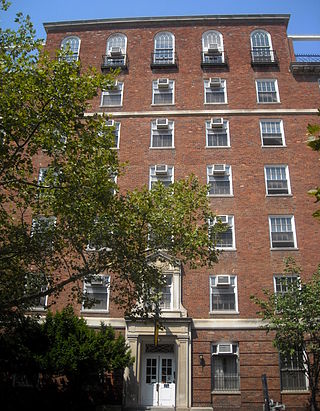
Hattie M. Strong Residence Hall is a women's dormitory on the campus of George Washington University in Washington, D.C. It was listed on the District of Columbia Inventory of Historic Sites in 1987 and on the National Register of Historic Places in 1991.
Charles F. Lembke was an American architect and contractor who was prominent in Valparaiso, Indiana. Lembke built many downtown Valparaiso-area buildings, such as the Memorial Opera House, Carnegie public Library, Hotel Lembke, and several local schools.

Lockridge Medical Clinic was a historic building notable for its Prairie School-style design by Frank Lloyd Wright, located in Whitefish, Montana, United States. Originally built as a medical clinic in 1963, the building served a variety of other commercial purposes before it was demolished by its owners in 2018.


















